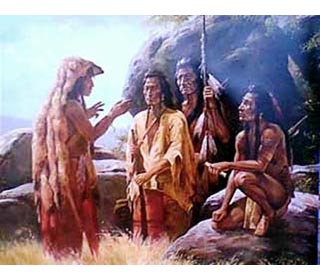Here at sunset each day came Gidanoneh the beautiful Iroquois maid. She walked on the shore and listened to the sweet strains of a mysterious song that arose from the water. Magical strains they were, amazing her with their sweetness. And they filled her sad heart with a strange joy.
For Gidanoneh was sad. Her father was poor, and had promised her to an old man. He was rich and laid before her door many gifts of furs and bright feathers. But his feet were too slow for the hunt, and his spirit too still for war. And Gidanoneh was young, and life lay bright before her; therefore, she dreaded the hard work waiting for her to do in the old man's lodge. So at sunset she walked by the lake, and wept with sorrow. Then the sweet strains of the mysterious song arose from the water, and comforted her heart.
And the sweet singer was Gayewas, the Spirit of the Lake and the Guardian of the Mountain Streams. One day, when floating on the water, he had seen the beautiful Gidanoneh, graceful and sad-eyed, walking on the shore. Unseen by her he had approached and softly sung his magic song, which had comforted her heart. So evening after evening at the sunset hour, he had sung to the maid.
The days passed, and the old man came to take Gidanoneh to his lodge. But weeping she hastened to the lake. There on the shore she found lying in her path two beautiful fish. And, lo, around them were sewn rows of shining silver brooches that dazzled her eyes with their light.
Forgetting her sorrow in wonder and delight, she stooped and, gathering the glistening brooches, fastened them upon her faded doeskin dress. Then she built a fire, and was roasting and eating the fish when her father found her.
He stopped in amazement as he looked at the silver brooches, for he had never seen such rich ones. "Surely," thought he, "an evil Spirit is tempting my daughter!" So in fear and rage he tore the brooches from her dress, and threw them down on the shore. Then he led the weeping maid back to his lodge.
But the fish she had tasted, had given her a thirst for the water of the blue lake, that she could not resist. And heedless of her father's cries, she ran from him, nor stopped until she reached the shore.
Falling upon her knees, she touched her lips to the water, and, as she eagerly drank, strong arms were thrown about her. She was drawn beneath the waves, and carried downward to the shining bottom of the lake. Then she heard a voice, as musical as the running brooks, calling her name. "Fear not, Gidanoneh," said the voice; "fear not, for I am Gayewas, the Spirit of the Lake."
And beside her she saw a warrior clad in glistening silver brooches. He gently led her to a lodge built of scarlet shells, and there she was happy with Gayewas.
As for her father, he wandered the night through on the shore, calling his daughter. At sunrise the waves parted, and from the water came her voice, and he saw Gidanoneh, and by her side was a handsome glistening warrior.
"My father," she said, "I shall return no more to my land, for I am the bride of Gayewas, the Spirit of the Lake. You will never behold me more. Farewell! Farewell!"
And as she finished speaking, the water slowly closed again, and the sweet strains of the mysterious song were borne to the shore, as the sad father slowly wended his way to his lodge. The Story of the Silver Brooches
This story of the Silver Brooches is featured in the book entitled the Red Indian Fairy Book by Frances Jenkins Olcott published in Boston, New York by Houghton Mifflin Company in 1917 |
